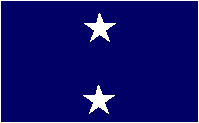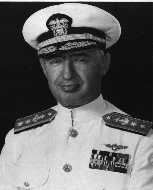

| Rear-Admiral
Joseph James Clark
Born: ? Died: ? Nickname: "J.J.", "Jocko" |
 |
In January 1944, Vice-Admiral Mitscher hoisted his flag on Yorktown, and Clark soon began to impress Mitscher. His fighting spirit and ability rated him high for promotion, and a mere month after Mitscher's takeover of the Fast Carriers, Clark was promoted to Rear-Admiral and COMCARDIV 13. His flagship, the new Hornet (CV-12), under Captain Miles Browning, did not report to Majuro Atoll until 18 March, and no carrier group was available, so Clark went into, as Professor Reynolds described it, "makee-learn" status and operated with TF58.
Clark
didn't have to wait for long. Rear-Admiral Samuel P. Ginder, COMTG58.3,
had proven to be an ineffective Task Group commander, and Mitscher wasted
no time replacing him in early April with his new "first lieutenant", Jocko
Clark.
Hoisting his flag back aboard
Yorktown, Clark and his ship became host to Mitscher again, who
held Clark in ever higher esteem.
During the Marianas campaign, Clark as COMTG58.1, performed brilliantly during a raid of the northern Marianas, which he as Mitscher's right hand and Rear-Admiral Harrill had been assigned to undertake. His fighting spirit won the day, and his excursion, plus his unwilligness to led Harrill's opposition to the operation affect its outcome, further highlighted his talent.
Arriving
in time to fight in the Battle of the Philippine Sea, Clark's planes played
a prominent part in it. In fact, Clark's ships were almost always closest
to the enemy. This continued after the battle; for when all of the Task
Groups returned to Eniwetok, Clark received permission for a strike against
Iwo and Chichi Jima, which he successfully conducted.
Clark missed out the Battle
of Leyte Gulf as Task Group commander since Vice-Admiral McCain took over
his Task Group in makee-learn status for COMTF38. Clark decided that he
didn't want to command a TG under Halsey and McCain, he asked to be relieved
and returned as soon as Mitscher took over again. This was in effect agreed
on, and Clark would return to the States when Rear-Admiral Montgomery would
be available of TG command.
Before that happened, however, Clark and Rear-Admiral Davison paid another visit to Iwo and Chichi Jima in early July , destroying further numbers of planes, and in early August again. When on 18 August McCain replaced Clark, the latter was in for a well-earned period of comparative rest.
Even when
idle and back in the states, Clark was a great aid to Mitscher. He suggested
that Marine pilots be employed on the carriers as replacements for fatigued
Navy fliers, and the Marines' planes would be coming in handy as well.
Clark finally returned to
the Pacific Fleet when Vice-Admiral Mitscher took over the Fast Carriers
again in February 1945, Clark getting back his TG 58.1, and now again embarked
on Hornet. Serving in the raids against Japan in 1945, Clark's forces
took several heavy attacks but escaped unharmed. His last adventure in
the war was a typhoon which he hit thanks to an incredibly poor performance
of TF38's weather expert. He was relieved on a regular basis of all combat
commands shortly before the end of the war, earning again a well deserved
shore billet. Clark became Vice-Admiral and commander of the 7th Fleet,
which now had the Fast Carriers, during the Korean War, and ended his career
as a full Admiral.